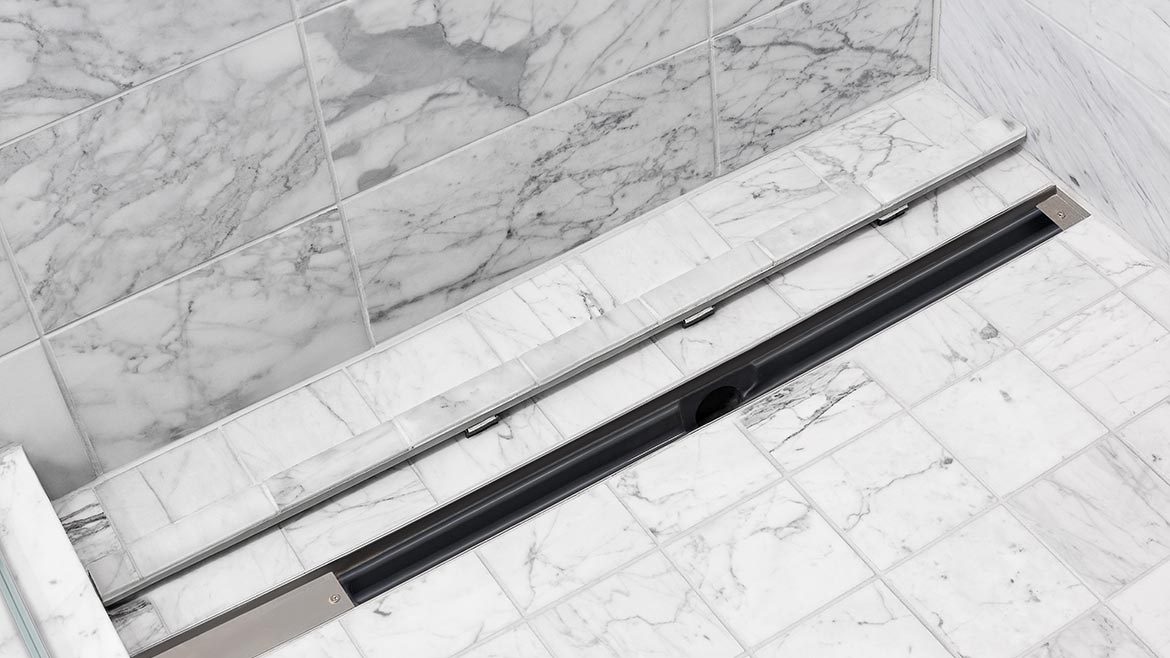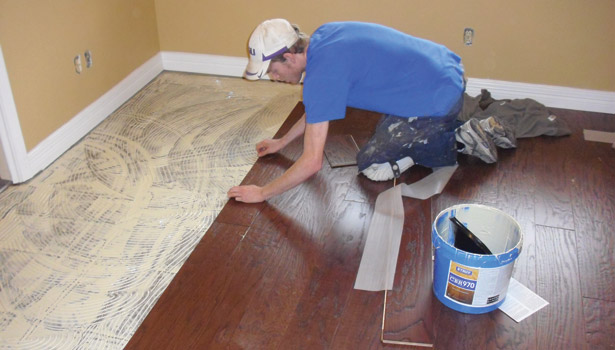There are basically three types of adhesive chemistries: Modified Silicone Polymers (or MS+), Polyurethanes, and Acrylics.
MS+. Modified silicone polymers are considered hybrids. They create a mechanical bond with wood, penetrating into the cell structure. However, should the adhesive end up on top of the finished wood, the outcome is quite different. The MS+ will not bond well to this coated surface and will clean off easily, giving MS+ adhesives excellent long-term cleanability.
With concrete, MS+ products form a chemical bond. MS+ polymers are unaffected by water when cured. They are also typically zero-VOC and therefore very ecologically friendly.
Polyurethanes. Polyurethanes combine with the wood’s lignin, made of complex chemical compounds that form parts of the cell structure, to create a chemical bond. Polyurethanes also create a mechanical bond with concrete. They are enormously strong and form an elastic bond. These adhesives are unaffected by water when cured.
The biggest drawback is that a polyurethane adhesive can also form an incredibly strong chemical bond with the polyurethane finish on topof the wood flooring. This makes trying to clean that spot on top of the floor you didn’t notice during installation an absolute nightmare. They must be cleaned when wet. Polyurethanes generally contain diisocyanates and solvents, and are considered low-VOC.
Acrylics. Acrylic adhesives usually consist of polyvinyl acetate emulsions. (They are also sometimes called “latex,”but the correct term is “acrylic.”) Acrylic adhesives are highly filled polymer dispersions in water. The typical curing occurs when the water leaves the dispersion with the help of solvents. The polymers coalesce, or fuse, thus creating a particle entanglement or matrix.
Acrylic adhesives are highly susceptible to moisture and usually require a flashing off period prior to floor installation. They clean off easily with water because of this, but will fail easily in a wet environment. When installed properly, they are an effective, proven option for engineered floors.
Unlike the other two adhesives, which are waterproof at full cure, acrylic adhesives are always susceptible to dilution from water or water vapor. On the plus side, acrylics do have a re-bonding capacity. Lastly, acrylic adhesives generally are low-VOC, and contain solvents.
What to Use? Here’s a quick guide to determine which adhesives are usually recommended for the various types of wood flooring products:
· Engineered plank and strip: Polyurethanes, MS+ Polymers, Acrylics.
· Parquet: Polyurethanes, MS+ Polymers, Acrylics.
· 3/4” solids: Polyurethanes (NOTE: Solids are typically nailed down, so make sure flooring manufacturer approves a glue-down installation).
· 3/4” shorts: Polyurethanes, MS+ Polymers.
· 5/16” solids: Polyurethanes, MS+ Polymers.
Other considerations. Working with adhesives and wood floors isn’t rocket science. Keep in mind, however, there are always new products and new technologies being introduced. So regardless of the type of adhesives with which you are working, or whether they are a new product or an old standby, here are some things to consider regarding your specific adhesive.
#1: Read the directions - Never assume that one particular adhesive will work just like another adhesive. There are such a great variety of adhesives on the market, even from the same manufacturer. Be sure to understand there are specific directions for making each one work correctly.
#2: Use the proper trowel! -Whether you are supposed to use a V-notch, U-notch or square-notch, there is a certain amount of adhesive that is supposed to be exposed to the air for a certain amount of time for it to work correctly. The trowel must have the right depth and spacing, and you need to hold it at the correct angle to get the proper spread rate. And here’s another good tip – if you grind a 3/16” trowel on concrete for 90 days or so, it’ll probably get down to an 1/8” trowel; so you’ll need to replace it.
#3: Don’t scrimp -Don’t try to cheat on the coverage rate and make your adhesive go a little further than it’s supposed to. If you don’t have enough adhesive, you’re just going to end up with hollow spots in your installation. If you’re using a combination adhesive/moisture mitigation product, you won’t have the moisture protection if you don’t have enough material on the floor. Also, use a quality adhesive for a quality floor. Your adhesive is the heart and soul of your installation. If it fails… you fail!
#4: Compare square footage -When you’re choosing an adhesive, do the math. Adhesives come in different size containers and they all have different spread rates. To accurately compare the price you have to do the simple math of figuring out the adhesive’s cost per square foot, not just the cost of the pail.
#5: Understand the meaning of the moisture wording on the adhesive label - There can be some confusion regarding the wording and warranties offered by adhesive manufacturers about moisture. Oftentimes you’ll read something about the product being good for a slab with up to 10 pounds (or whatever number) of moisture. Many contractors interpret that as meaning it’s okay to install the floor with that adhesive at that moisture level; but that isn’t necessarily true. What the adhesive manufacturer is saying is that their adhesive will work under those moisture conditions—not that their product will protect the wood floor from that moisture.
#6: “Check ‘nprep” the subfloor-Many failed glue-down floors are caused by contractors not taking the time to properly check and prepare the subfloor. A concrete slab should be clean, dry and flat. If a slab isn’t clean, the adhesive will form a bond with the debris, not the slab.
Now that you’ve increased your hardwood flooring adhesive knowledge and vocabulary, you should be well prepared to tackle your next glue-down installation with confidence. Once you become proficient in your adhesive know-how, you can also work on the math of adding dollars to your bottom line.
Rick Brian is President of R. B. Brian and Associates, Inc.
(www.RBBAinc.com), a management and marketing consulting company he founded in 1997. His clients are primarily manufacturers and distributors in the hardwood flooring and building products industries. Rick is a former president of Robbins Hardwood Flooring and past board member of the NWFA, MFMA, and NOFMA. He is currently a member of the NAFCD and NWFA. RBBA is headquartered in Southern Pines, NC.
513/310-6938 rbrian@RBBAinc.com.

















